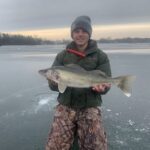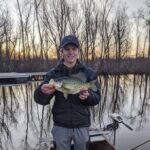Hey there, fellow anglers! If you’ve ever ventured into the realm of bass fishing, you know that each waterbody presents its own set of challenges. Heavy vegetation can be one of those challenges that makes fishing quit difficult at times. When it comes to fishing in weedy lakes, not all lures are created equal. Some lures will excel in these conditions while others will make your time on the water miserable. Fear not, because this article will reveal some of the best bass fishing lures for weedy lakes. Whether you’re a seasoned pro or just starting out, we’ve got you covered.
As always, fishing education and conservation are our priorities here at The Angler’s Line. Feel free to sign up for our free newsletter to join our community and stay up to date! Lets get started!
Table Of Contents:
- Understanding The Best Lures For Weeds
- Specific Lure Recommendations
- Tips For Fishing In The Weeds
- Conservation
What Makes A Lure Effective In The Weeds?
Now, before we jump directly into the specific lures, let’s take a quick look at what to look for when choosing a lure to fish in heavy vegetation.
When fishing in and among vegetation, there are several considerations to make. If you plan on fishing the bottom, having a weed guard or weedless setup is critical.
For mid-column lures you can begin to use exposed hooks, but your equipment becomes very important. If you want to fish exposed hooks in weedy lakes, a heavy rod and line setup will help tremendously. This heavier gear will allow you to rip your lure out of the weeds and clear off the hooks. You won’t be able to break free from the weeds if your rod and line setup is too light.
For topwater lures, the types of hooks you can get away with depends on whether the vegetation is floating or not. If the weeds are submerged, you can get away with pretty much any topwater you would like. If the weeds are floating, choose a topwater lure that is weedless or has hooks that face upwards to avoid getting snagged.
Best Bass Fishing Lures For Weedy Lakes
From bottom contact, mid-column, to topwater, we’ve got you covered.
Spinnerbaits
Ah, the trusty spinnerbait – a classic lure when it comes to bass fishing. The spinnerbait is a great option for covering water and finding active fish. Spinnerbaits have a wire frame which connects the skirt to the blade. This piece of wire also acts as a sort of weed guard for the lure. The spinnerbait is ideal for fishing sparse vegetation, but will not work in extremely thick weeds. The key here is to keep that spinnerbait moving and above the tops of the weeds. Use a lighter weight if necessary and keep your rod tip up. The last thing you want is for the spinnerbait to sink deep into the weeds and completely wrap up the blades.
Bass Jigs
Jigs are one of the most versatile lure in a bass angler’s arsenal, and they work in weedy lakes as well. There are a lot of different types of bass jigs, but be sure to pick a grass jig for these conditions. Grass jigs will have a more pointed head and slightly stiffer weed guard. This will allow you to fish in most weeds effectively, however they are not ideal for extremely heavy weed cover. I like to use bass jigs in pressured bodies of water where most anglers are fishing with Texas-rigs. The slightly different profile and action can allow you to get more bites where bass haven’t seen it much before. Be sure to choose a trailer for your jig that has a slim profile and slides easily through the vegetation without hanging up.

Texas-Rigged Soft Plastics
When most angler think about fishing for bass in the weeds, a Texas-rig is probably one of the first things that comes to mind. A Texas-rig refers to hooking a soft plastic in such a way that the hook point is embedded in the lure. This makes the presentation weedless and prevents it from constantly getting hung up. When you get a bite and set the hook, the hook point breaks through the soft plastic and hooks the fish. Texas-Rigged soft plastics are ideal for fishing extremely thick vegetation. Simply cast it out, let it hit bottom, and slowly jig it along the bottom in and among the weeds. When the water temperature is colder, choose a soft plastic that has less action. When the water temperature is warm, a soft plastic with lots of appendages and action is often the way to go.
Hollow Body Frogs
Hollow body frogs and weeds go together like peanut butter and jelly. These topwater lures are designed with upward facing hooks that tuck behind the body of the lure. When a bass bites, the frog body compresses and exposes the hook points. Topwater lures in general work best when the water temperature is warm. Hollow body frogs allow you fish in some of the thickest and nastiest cover on your lake without worrying about fouling up. Frog fishing requires specialized equipment however. A heavy power baitcasting rod with braided line between 30 lb to 70 lb test is what I recommend. You need to set the hook hard and have full control over the fish to prevent them from burying themselves in the weeds.
Drop Shots
Drop shots are often overlooked by anglers when it comes to fishing weeds, but they are extremely effective. A drop shot is rig is a hook that has a dropper line attached to a weight on the bottom. The benefit to a drop shot is that you can adjust the dropper length for the bottom composition that you are fishing. If the weeds are only within a foot of bottom, you can get away with a shorter dropper length. However, you have the ability to suspend your lure much higher in the water column if the weeds grow up higher. Use the soft plastic of your choice. Either nose hook the plastic or even texas-rig it for a more weedless setup. I like fishing drop shots in pockets and voids in the weeds. Fish this lure slowly, and shake the soft plastic in place without really even moving the weight.
Tips for Successful Weed Fishing: Mastering the Art
Now that we’ve covered some of the top-notch lures, let’s sprinkle in a few tips to help you dominate the weedy lakes like a pro.
1. Read the Weeds: Sometimes when looking at a lake, it can seem like an endless expanse of weeds. However, learn to find the pockets and subtle nuances within these large weed beds and you’ll likely find the sweet spots.
2. Adjust Your Approach: As the day progresses, bass behavior changes. Adapt your lure retrieval speed and depth according to the time of day and water temperature.
3. Beef Up Your Gear: In weedy waters, you need the appropriate setup. Use a heavier rod and line setup than you would typically use for the technique you are fishing. You need to be able to control the fish and pull them out of the weeds before they can bury themselves.
4. Embrace Versatility: Don’t be afraid to switch things up. Sometimes, a slight tweak in your technique or lure choice can turn a slow day into a fishing frenzy.
Conservation and Ethical Fishing Practices
As responsible anglers, it’s crucial to prioritize conservation and practice ethical fishing
As responsible anglers, it’s crucial to prioritize conservation and practice ethical fishing. Adhere to catch-and-release guidelines whenever possible to preserve the bass population for future generations. Handle fish with care, use barbless hooks to minimize injury, and return them to the water as quickly and gently as possible. Respect fish and wildlife habitats by minimizing your impact and leaving the environment as pristine as you found it.
And there you have it, fellow anglers – a comprehensive guide to the best bass fishing lures for weedy lakes. Between spinnerbaits, Texas-rigged soft plastics, frog imitations, jigs, and drop shots, you’re ready to conquer the challenge. Remember, fishing in weedy lakes requires the right lures and tackle to fish effectively. So, grab your gear, embrace the challenge, and put your newfound knowledge to the test! Tight Lines!
- The Ultimate Kids Fishing Guide

- Ice Fishing For Walleye: Everything You Need To Know

- Midday Walleye: A Complete Breakdown Of Daytime Walleye Fishing

- Live Bait For Walleye: Everything You Need To Know

- Lure Talk: Full Guide On Fishing Crankbaits For Walleye

- Lure Talk: Best Crappie Lures For Each Season

